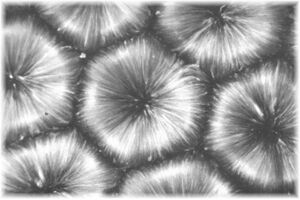Bénard convection
From Anarchy In Action

"Shown is a bed of Bermuda grass, Cynodon dactylon. The color of the grass turns from green to brown as it transitions to dormency in fall. Frost damage by convecting air produced a particular pattern of green/brown regions referred to as "tiger striping". The spatial scale of the pattern is ≈20cm or 10in. Notice the pronounced boundary effects, such as brown regions aligned to the edge of the lawn. This is suggestive of the underlying pattern-forming process. For the underlying process, see e.g. Ackerson, B.J., Beier, R.A. & Martin, D.L. Ground level air convection produces frost damage patterns in turfgrass. Int J Biometeorol 59, 1655–1665 (2015). https://doi.org/10.1007/s00484-015-0972-3 The picture was taken with a Fairphone 4, ISO 112, f/1.8 and 1/336s exposure. It was cropped from the original with GIMP to anonymize the location. Taken in Leeland, North Carolina, USA on November 21 2023. A close up of the same turf is shown in the picture on the right. The scale bar is 15cm / 6in. Tiger striping grass closeup" Source: https://en.wikipedia.org/wiki/Rayleigh%E2%80%93B%C3%A9nard_convection#/media/File:Tiger_striping_grass.png
The Bénard convection is a chemical reaction that's an example of self-organizing order emerging far from equilibrium. When certain liquids, including silicone oil[1], are uniformly heated from below, an orderly honeycomb-like pattern of hexagons emerges.
In Brussels in the 1960s, the chemist Ilya Prigogine closely examined Henri Bénard's discovery that heating a liquid from below creates a kind of heat convection (meaning a transfer of heat) to the liquid's center, at which point the honeycomb pattern emerges. The convection also occurs in nonhuman nature. Heat flowing from the land into sky creates hexagonal patterns in desert sand dunes and Arctic ice fields.[2]
